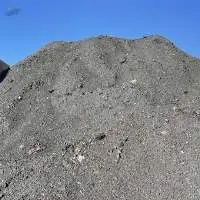
Fly ash is an inexpensive replacement for portland cement used in concrete, while it actually improves strength, segregation, and ease of pumping of the concrete. Fly ash is also used as an ingredient in brick, block, paving, and structural fills. Fly ash can be a cost effective partial substitute for Portland cement in markets that are experiencing supply shortages. An industrial by-product that is otherwise waste, fly ash is environmentally friendly because it is recycled and has low embodied energy. Because fly ash cement requires less water than portland cement, it is easier to use in cold weather. It can be formulated to produce various set times, cold weather resistances, strengths and strength gains, depending on the job. Fly ash can be used sparingly as an admixture or in large amounts to replace portland cement. The material is somewhat lighter than portland cement. 50 Kgs, 1000 Kgs & Bulkers of 20000 Kgs.
Fly ash is a by-product produced while burning finely ground coal in a boiler to produce electricity. It is removed from the plant exhaust gases primarily by electrostatic precipitators or baghouses and secondarily by scrubber systems. Physically, fly ash is a very fine, powdery material, composed mostly of silica. Nearly all particles are spherical in shape. Fly ash is a pozzolan, a siliceous material which in the presence of water will react with calcium hydroxide at ordinary temperatures to produce cementitious compounds. SiO2, Al2O3, Fe2O3 and occasionally CaO are the main chemical components present in fly ashes. Fly ash significantly improves concrete performance in different ways and also provides many benefits in cement and non-cement applications. Fly Ash colour can vary from grey and dark grey, yellowish tan and light to brownish. ADVANTAGES OF FLY ASH IN CONCRETE Fly Ash is a Pozzolan Improves concrete workability and lowers water demand Sulfate and Alkali Aggregate Resistancet Rise in compressive strength over time Environment friendly CEMENTATION Fly Ash is optimized for its fineness while reducing the water demand and improving the chemical compositions to maximise its benefits when used in concrete. Fly-ash can also be used as an add-on to concrete mixture with pozzolanic and/or latent hydraulic properties. We at CEMENTATION selectively collect fly ash and subject to rigorous testing, further refines these collected materials to produce quality fly ash products meeting the needs of our customers.
Mill scale, is formed on the outer surfaces of plates, sheets or profiles when they are being produced by rolling hot iron or steel billets in rolling or steel mills. It looks like a hard brittle sand and is mainly composed of iron oxides, mostly ferric, and is bluish black in color. Being produced during the reheating, conditioning and hot rolling operation for the production of steel articles, the mill scale initially adheres to the steel surface and protects it from atmospheric corrosion, provided no break occurs in this coating. From the chemical and physical analysis performed on the scrap, and according to the european environmental rules, the material has been classified as a special non dangerous waste, listed in green list In particular the mill scale can be classified as follows: Einecs (european commission no.): 266-007-8 Waste code: 10 02 10 Basel code: b 12 30 Hs code: 2619.00
We are glad to propose 500 MT of stain less steel mill scale. Mill scale is formed on the outer surfaces during by the hot rolling lamination of stainless-steel products. At a visual inspection the material is a hard brittle sand and is mainly composed of iron oxides, mostly ferric, and is bluish black in colour, but it also contains considerable alloying elements such as chromium and nickel. The recovery ratio after melting in furnace for the most valuable alloy elements is: - Ni: 3.5 - 4.5% - Cr: 6-8% From the chemical and physical analysis performed on the scrap, and according to the European environmental rules, the material has been classified as a special non dangerous waste, listed in green list. In particular the mill scale can be classified as follows: Waste code: 10 02 10 The material is stored on cemented flooring, and it can be loaded loose in tipper trucks or containers. Chemical analysis of the material is available on request.
Features Of Fly Ash Fly ash, also known as flue-ash is a residue which is generated during combustion and consists of fine particles. There are impurities in coal which mostly consist of clays, limestone and dolomite particles. These turn up into ash as they cannot be completely burned. Fly ash is useful in a number of ways and is one of the most researched upon mineral source. It is mainly a pozzolanic substance which contains aluminum and silicon material which in return due to the presence of water can take form of cement. A lot of research and development initiative have been taken place across the globe to build and develop technologies that can utilize the full potential of fly ash. Royal Mineral takes care to ensure flawless production stages.
Supplier: Fly ash, granulated iron blast furnace slag (gbfs), potassium feldspar , sodium feldspar , stpp sodium tripolyphosphate, zirconium silicates & zirconium flours
Fly Ash Minimum Quantity - 1 Ship load (30,000 MT) Payment Term - L/C



